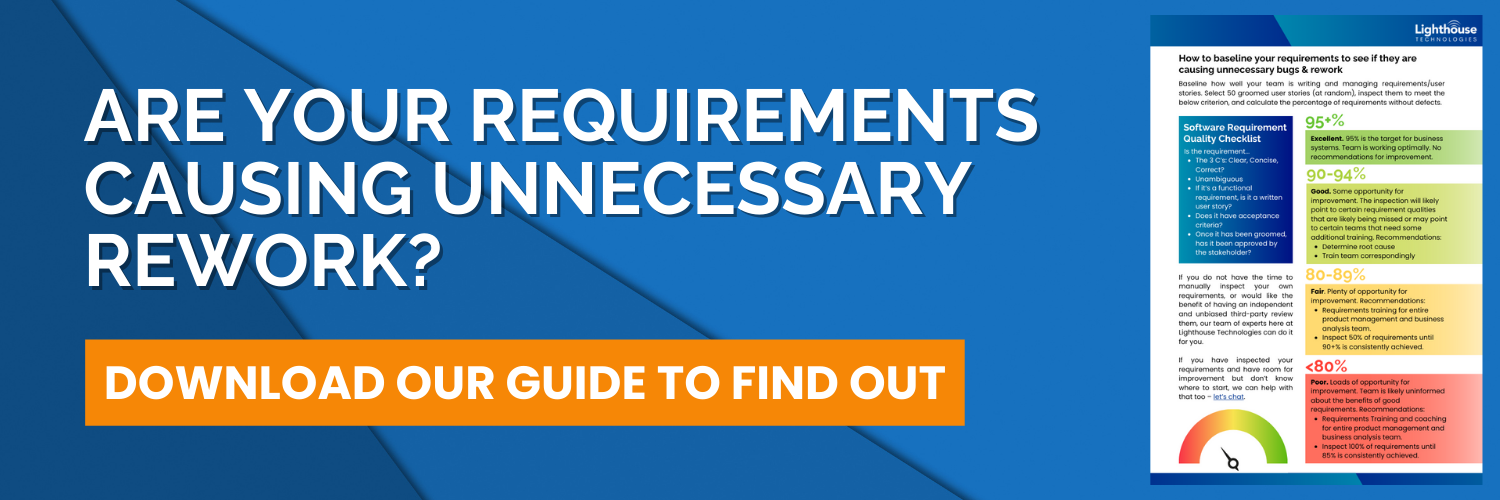If your software team is spending more time fixing bugs than developing new features, we have good news and bad news. The bad news is that poorly written requirements are likely a root cause of your never-ending rework. The good news? By shifting left, improving these requirements is not only easy, but the most effective way to reduce rework.
If that sounds too good to be true, check out this graph that depicts how many requirement defects leak to development based on process maturity. As you can see, ad-hoc teams deliver 10x more requirement defects into development than teams with well-managed processes.

Since requirements are the foundation that all code is built on, getting them right the first time is crucial to preventing unnecessary rework, delays, and costs. Although requirements sometime seem like a technical task that can be left to software teams, we encourage CTOs to reconsider their involvement in assuring they are well written and unambiguous. Here’s why:
1. Strategic Alignment & Meeting Business Objectives
Clearly, CTOs are not just technologists – they are strategic partners in achieving business goals. Clear requirements bridge the communication gap between technical teams and stakeholders. When requirements are aligned with business objectives, the resulting software solution is not just a technical marvel but a catalyst for achieving organizational success. Active participation in requirement planning and management enables CTOs to infuse a holistic vision, ensuring the software team navigates technical intricacies without getting tunnel vision and losing sight of the big picture.
2. Reduce Rework and Cost
Ambiguous or poorly defined requirements lead to significant risks and inconsistencies during the development process. If a user story can be interpreted differently by the key readers (author, user, tester, developer) then it is likely that one of them will be working to the wrong understanding, generating waste and rework. Identifying and addressing these misunderstandings early on is crucial for preventing delays and cost overruns. Pro Tip – Download our guide to assess your user stories and count how many of them have defects.
3. Avoid Scope Creep & Improve Time-to-Market
Lack of detail or incomplete specifications often results in missing or unexpected features which inevitably causes churn and expands project scope. If a user story is incomplete and the developer builds it to that spec, and then subsequently discovers it was incomplete, they often have tear out some of their old code and rebuild it to the complete specification. In addition, these requirement details increase the system scope which generally cause these features to slip into subsequent sprints. Well-defined and complete requirements serve as a compass in accurately sizing a project’s scope – providing a clear understanding of how much time and effort it will actually take to develop the desired product. Pro Tip – If your sprint velocity is inconsistent or you often slide features to subsequent sprints, incomplete requirements is often the culprit.
4. Better Quality Software & Satisfied Stakeholders
When requirements are thorough and unambiguous, they pave the way for more effective testing procedures, ensuring that every aspect of the software aligns with the intended specifications. This precision in the initial phase directly translates into a higher-quality end product, as well as happier users and stakeholders, by reducing the likelihood of bugs, glitches, and post-launch issues.
5. Improved Communication & Managing C-Suite Expectations
CTOs, often the orchestrators of project road maps, benefit from deeper involvement in improving requirements. This not only refines their ability to set achievable timelines but also enhances their credibility with the C-Suite and Board by helping the development team start on the right foot. Sure, it’s not going to fix everything, but if you start at the front of the dev cycle, you get the biggest bang for the buck. How great would it be if you had confidence that your dev team was going to meet your release dates.
A CTO’s attention to software project requirements is about more than just technical specifications – it’s a strategic imperative. It impacts the entire development process, from initial planning to execution, and is foundational for achieving the desired outcomes efficiently and effectively.
If you discover your requirements are in need of improvement but you don’t know were to start, we can help – let’s chat.






